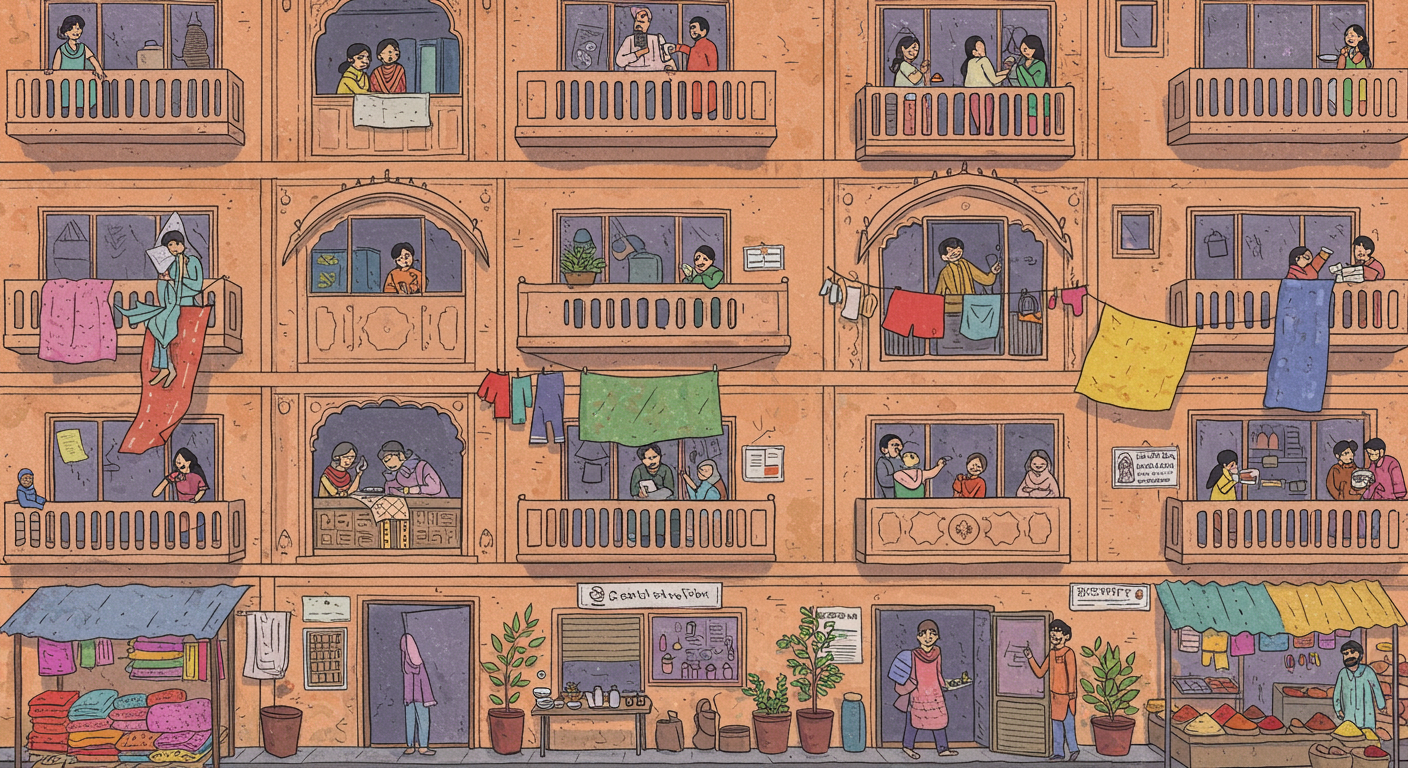Pagdi System in India: A Relic On Its Way Out
The Pagdi System is a unique and deeply rooted form of tenancy in India, particularly prominent in older parts of cities like Mumbai, Delhi and Kolkata. Unlike conventional rental arrangements, this system offers tenants more than mere occupancy, it grants them semi-ownership rights, and the ability to sublet the premises or sell the property to another person. This arrangement blurs traditional roles, fostering a shared stake between landlord and tenant in the property's management. At its core, the Pagdi system ensures long-term security for tenants, which frequently extends across generations.
Origin
Also known as the ‘Pagdi-Kirayedar’ system, the Pagdi system has diminished to a few parts of India but is still widely prevalent in Mumbai, Delhi and Kolkata especially the older areas.
Originating in the pre-independence era to navigate the heavy taxation policies imposed by the British, the Pagdi system has stood the test of time and continues to serve a crucial role in the modern real estate sector. The system was practically designed to be a workaround to reduce the burden of taxes on both sides and this clever adaptation not only ensured that tenants could live affordably but also provided landlords with a steady source of income, thus stabilizing the local economy while subtly challenging the financial constraints imposed during the colonial rule.
Up until 1999, there was no statutory provision that supported this system. However, the Maharashtra Rent Control Act of 1999 legalized this system under Section 56 of the Act which provides that the Tenant can receive money or other considerations when relinquishing, transferring, or assigning their tenancy rights and the Landlords are also to receive money for granting or renewing a lease, or for consenting to a lease transfer according to the agreement between the two.
Functioning
At its core, the Pagdi system is like the conventional rental system that prevails. The only difference is that the Tenant also owns a part of the property and has the ability to sublet or sell it.
Under this system, the tenant pays a lump sum amount known as ‘Pagdi’ to the landlord, usually a multiple of the monthly rent. In exchange, the landlord ensures that the tenant pays a minimal amount of rent which is lower than the existing market rates while still being a co-owner of the property.
It is important to note that while the Pagdi Tenant might be considered a co-owner of the house, they don’t own the land it stands on.For tax purposes, it's crucial to understand that Pagdi tenants do not own the property itself. What they possess is the right to occupy it.
Therefore, when they receive compensation for leaving the premises, this amount is not treated as the sale proceeds of a house. Rather, it represents payment for the transfer of their right to reside in the property.
Transfer of Ownership
As a part-owner of the property, the tenant also possesses the ability to sell their interest. Unlike conventional property transactions, transferring ownership within the Pagdi system is a complex process. It necessitates a three-party agreement involving the landlord, the current tenant, and the incoming tenant or prospective buyer. This crucial agreement ensures mutual consent on all conditions, including the "Pagdi" (or premium) payment to the landlord.
Should a tenant choose to transfer their rights, a portion of the sale proceeds, typically ranging from 30% to 50%, must be paid to the landlord. This exact percentage isn't fixed, and it depends on the property's location and any mutual agreements between the parties. Additionally, for transfer to non-blood relatives, a No-objection Certificate is required which prevents any future claims in respect to the property.
Normally, the Tenant is the sole occupier of the flat meaning he cannot sub-let it to another person but in this system, things are a little different. Here, the Tenant has the right to further sub-let it to another person which is after the consent of the Landlord.
The sub-letting, however, does carry a cost for the Tenant. In case of sub-letting, the rental income is usually divided in a ratio of 35:65. This means that out of the total rental income, only 35% goes to the Tenant whereas the rest goes to the Landlord. The consent of the Landlord is necessary, and it is advisable for the Tenant that the consent be taken in writing to avoid any future discrepancies.
Inheritance and Succession:
Section 7 (15) (d) of the Maharashtra Rent Control Act, 1999, states that a tenant’s family member who has been living with the deceased tenant at the time of his/her death shall be eligible first from the family as the successor to succeed the tenancy.
Under the Pagdi system, testamentary succession is not possible as the tenancy rights are not transferable through a Will because they are inherently specific to the individual tenant and thus fall outside the scope of testamentary disposition.
To assert a claim to the deceased tenant's rights, a family member is required to furnish proof of continuous cohabitation with the tenant up to the point of their demise. This stipulation ensures that succession to the tenancy is limited to those who shared an intimate familial bond and maintained a shared residence with the original tenant. Upon successful establishment as the legitimate heir and successor, the new tenant is then entitled to request the landlord to issue a fresh rent receipt bearing their name.
Current times and why it is fading:
The Pagdi system traces its origins to the British era, initially devised as a mechanism to avoid excessive property taxation. Over time, it became an entrenched tenancy practice, particularly in metropolitan cities such as Mumbai, Delhi, and Kolkata. Even today, it continues to survive despite sweeping reforms in property and tenancy laws.
In cities like Mumbai, where real estate prices have escalated steeply, a significant portion of the population, often estimated at around 30–35% is migratory or “floating.” For such groups, the Pagdi system offered a relatively uncomplicated and affordable form of tenancy, with the additional advantage that it remained largely outside the taxation net for decades.
Pagdi system was never truly fair, it heavily favoured tenants at the expense of landlords, while also locking cities into outdated housing stock. Yet, it undeniably played a role in providing affordable shelter to millions of families when urban India had no other safety net. Today, however, the cracks are impossible to ignore literally. Collapsing chawls, unsafe structures, and disputes between landlords, tenants, and developers are everyday news. Redevelopment is slowly dismantling the system, one building at a time.
Various factors are contributing to the decline of this System, which are:
(i) With aging buildings in dire need of repair, redevelopment projects are displacing old Pagdi tenancies, offering tenants new flats in exchange;
(ii) The gap between controlled rent and market value has become unsustainable. For eg. A 500 sq. ft. flat in South Mumbai might fetch INR 40,000 a month in the open market, but under Pagdi, the rent could be less than INR 500;
(iii) The system discourages property maintenance, reducing the incentive for landlords and affecting urban infrastructure;
The Pagdi system is thus heading towards extinction, not by sudden abolition but by steady erosion. What remains is its legacy: a reminder of how housing policies, meant as temporary fixes, can endure for generations and reshape entire cities.
Conclusion:
Given the government's lack of clarity and ongoing legal challenges, the future of the Pagdi system is uncertain, creating anxiety for both tenants and landlords. A proactive approach with clear reforms is crucial to finding a fair, long-term solution that balances tradition with modern housing market realities. This complex, historically significant landlord-tenant arrangement, which currently appears obsolete, requires either significant changes to suit contemporary needs or complete nullification.

